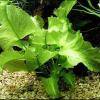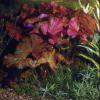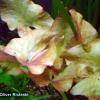Nymphaea zenkeri
Scientific name: Nymphaea zenkeri
Family: Nymphaecaceae
Maximum size reached under cultivation: 5 - 30 cm (1.97 - 11.81 inch)
014
Recommended pH range: 6.5 - 7.2
Recommended water hardness: 4 - 8°dGH (71.43 - 142.86ppm)
0°C 32°F30°C 86°F
Recommended temperature range: 22 - 28 °C (71.6 - 82.4°F)
Preferred propagation method: Bulb shoots
Native to: Africa
Growth rate: Normal
Recommended substrate: Fine gravel
Lighting requirements: Bright
Ideal placement in tank: Foreground
Common Name
Red Tiger Lotus
Origin
Tropical Africa; this plant is naturally found in slow-moving waters, lakes, and wetlands across West and Central Africa. Reports of its origin in Southeast Asia are likely due to cultivated forms or confusion with other species of Nymphaea.
Planting Area
This is a foreground to midground specimen plant. It should be given ample space with minimal nearby planting to let its large, decorative leaves spread. It works well as a focal point in aquascapes.
Propagation
Nymphaea zenkeri propagates from a bulb. When the bulb matures, it may develop lateral shoots that can be separated and replanted. Ensure that new bulbs are not buried completely in the substrate, as they may rot. Plant them with the crown exposed for proper development. Some specimens may also flower and produce seeds, but this is uncommon in aquarium conditions.
Difficulty
Medium
Short Description
Known for its deep red or mottled leaves, Nymphaea zenkeri—often called Red Tiger Lotus—is a striking aquatic plant ideal for larger aquariums. It prefers slow-moving water due to its delicate stems. Bright lighting enhances its leaf coloration, while a nutrient-rich substrate supports steady growth. Once established, the plant sends up floating leaves, adding a vertical dimension to the aquascape. CO2 supplementation is not required but can improve growth and coloration.
Note: Nymphaea zenkeri is a true aquatic plant that can grow both submerged and emersed. In aquariums, it's usually cultivated submerged, although it may occasionally send leaves to the surface.
FAQs
-
Can Tiger Lotus grow fully submerged in an aquarium?
Yes, Tiger Lotus can grow fully submerged and is commonly used as an aquarium plant. However, if not pruned, it may send leaves to the surface and try to flower above water.
-
Why are my Tiger Lotus leaves turning green instead of red?
Leaf coloration depends on lighting intensity and nutrient availability. Bright lighting and rich substrate encourage deeper red or purple tones. In lower light, leaves tend to remain green.
-
Should I remove surface leaves on Tiger Lotus?
If you're growing Tiger Lotus as a mid- or foreground plant, regularly trimming surface-reaching leaves helps keep it compact and bushy. Otherwise, it may overshadow other plants below.
-
How does Tiger Lotus propagate in aquariums?
It reproduces from a bulb. Over time, the plant produces offshoots or new bulbs. These can be carefully separated and replanted once roots or leaves form.
-
Can Tiger Lotus be used in low-tech aquariums?
Yes, but its growth and coloration may be less impressive. In low-tech setups without CO2 and intense lighting, expect slower growth and more green than red foliage.
-
Tips for bold specimen presentation?
To showcase Tiger Lotus as a striking centerpiece, plant it in an open foreground or midground area with space around it. Use a nutrient-rich substrate, provide intense lighting, and prune surface leaves regularly to keep growth compact and vibrant. Its deep red coloration will contrast beautifully with green background plants.

 Barclaya longifolia
Barclaya longifolia Nuphar japonicum
Nuphar japonicum Nymphaea lotus
Nymphaea lotus Nymphaea maculata
Nymphaea maculata Nymphaea pubescens
Nymphaea pubescens